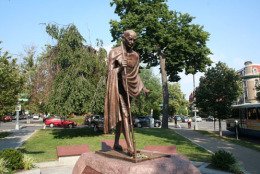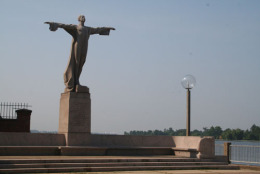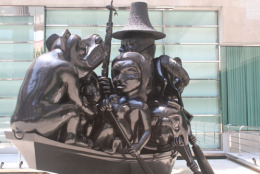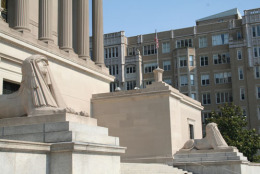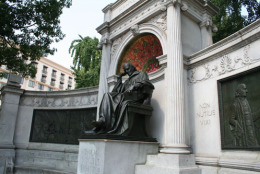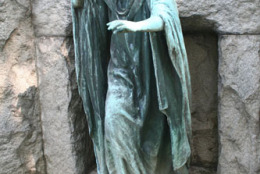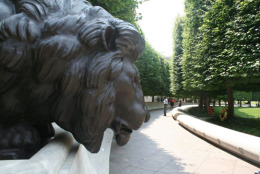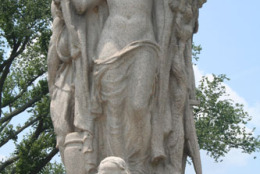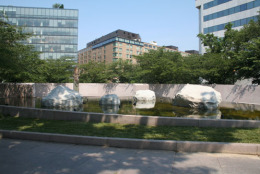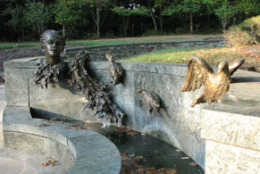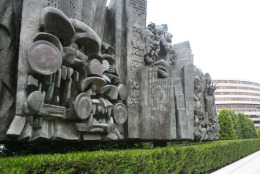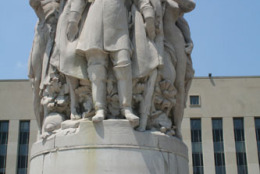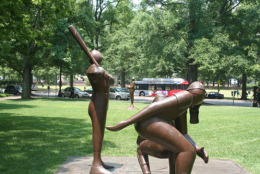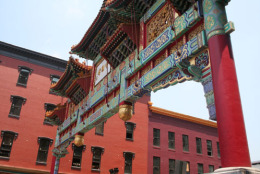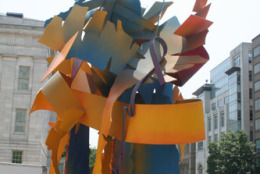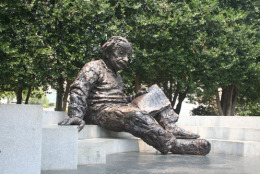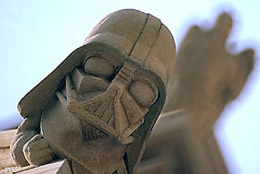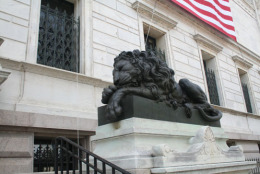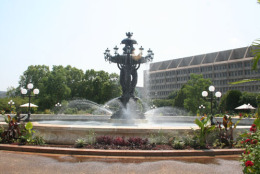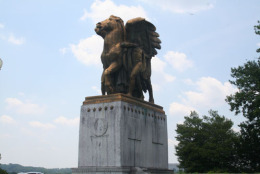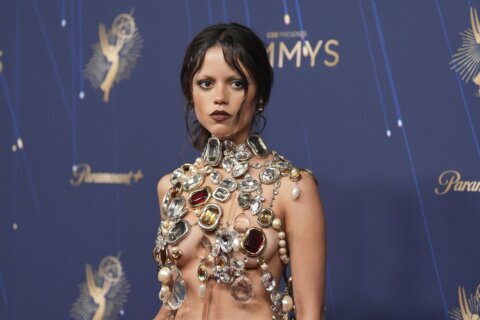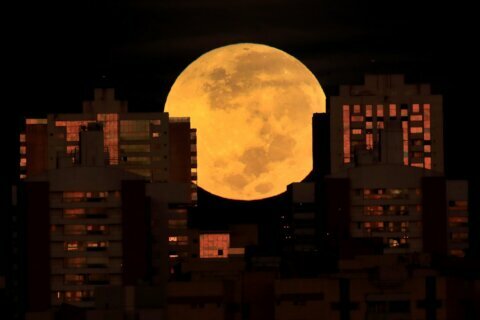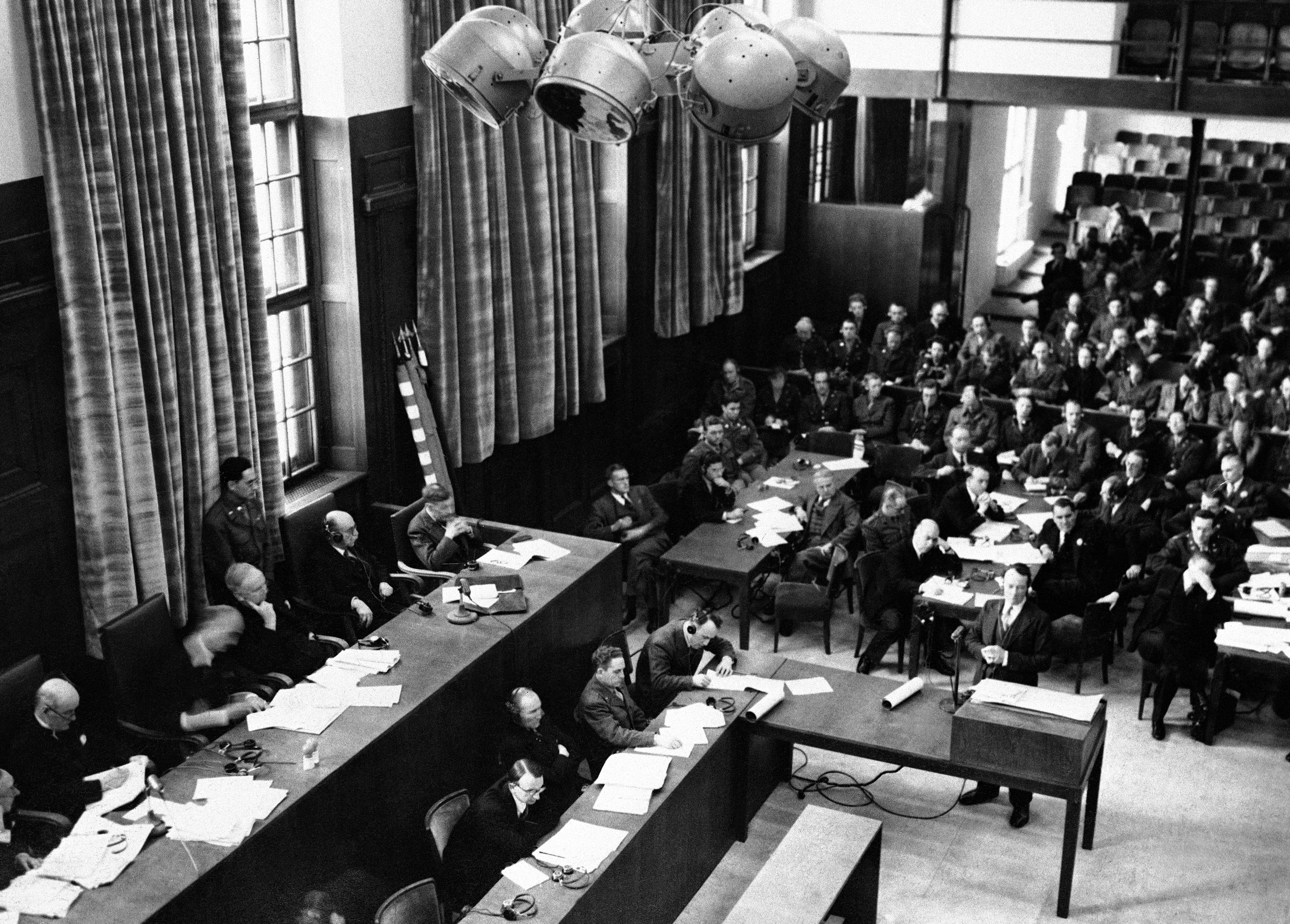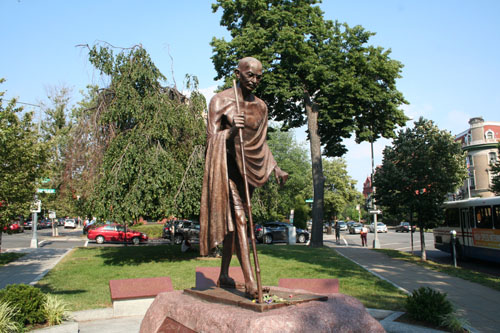
From 1915 until his death in 1948, Mahatma Gandhi used non-violent protest to free India from British occupation and become an independent country. His statue, in front of the Embassy of India on Massachusetts Avenue NW, stands 8 feet 8 inches tall and depicts him mid-stride in his most famous march against the British salt tax in 1930. As an icon of Indian nationalism, he stands not only in D.C. but also in cities such as New York, Atlanta, Houston, San Franscico, Salt Lake City and St. Louis. (Special to WTOP/Tiffanie Reynolds)
Read More...
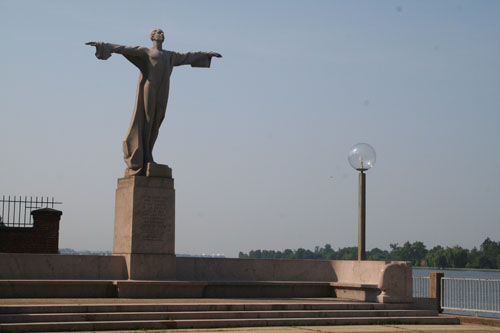
Looking at this woman holding open her arms, you can almost feel the ocean breeze brushing underneath them and pushing her back toward the ship. This free spirit was created largely through donations from more than 25,000 women to honor those men who remained on the Titanic in order to save the women and children on board.
Completed in 1918, it wasn't displayed until 1930 and has gone through several moves since, from New Hampshire Avenue along the Potomac River, to storage in Fort Washington, Md., to its current location at Washington Channel Park on P Street SW. (Special to WTOP/Tiffanie Reynolds)
Read More...
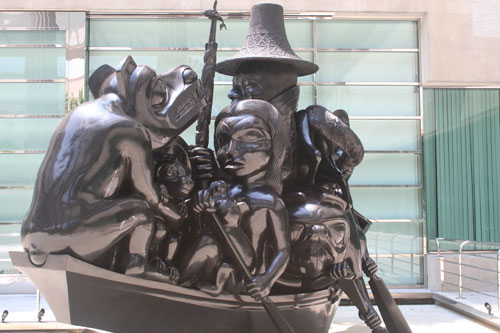
Outside the Canadian Embassy stands this canoe, holding travelers that represent Canadian history. Haida Gwaii, also known as the Queen Charlotte Islands, is an island chain in British Columbia known for its diverse nation. Each character on the canoe represents something about Haida Gwaii, such as "The Bear," who sits proudly as the leader looking into the past. Haida Gwaii stands for "Islands of the People" and all of these allegorical creatures symbolize their mythology. (Special to WTOP/Katy Stang)
Read More...
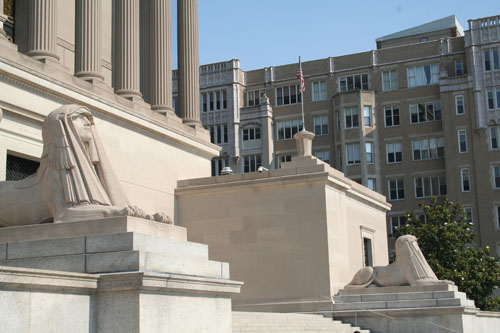
Fans of books like "The Lost Symbol" will love the rich history behind the sphinxes at the House of the Temple of the Scottish Rite on 16th Street NW. Known to guard mysteries and secrets, in ancient times sphinxes were mythological creatures and often symbols that represent gods. The two that adorn this temple represent power (L) and wisdom (R) and embody all of the secrecy and tradition of freemasonry. (Special to WTOP/Katy Stang)
Read More...
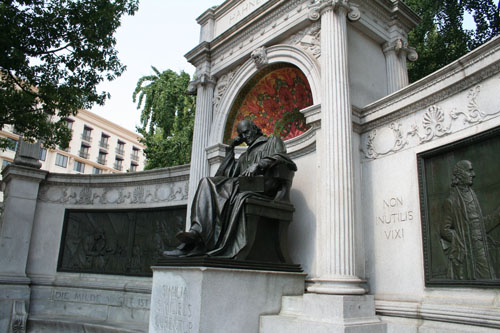
This statue near Scott Circle is dedicated to the German physician Hahnemann, who spent his life working in medicine. Hahnemann created homeopathy, which focuses on the healing power of symptoms, and the panels around the statue show the progression of his theory. The script on the bottom of his throne reads "Similia Similibus Curantur," meaning "like cures the like," which is the founding concept he contributed to medicine. (Special to WTOP/Tiffanie Reynolds & Katy Stang)
Read More...
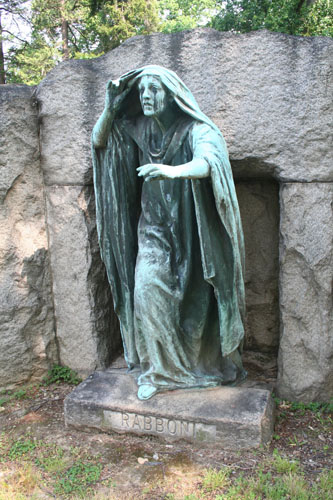
This sculpture by Gutzon Borglum, who sculpted Mount Rushmore, is a tribute to prominent banker Charles M. Ffoulke and family. It is a depiction of Mary Magdalene walking out of the small stone alcove built behind her, but what makes the statue really interesting is what time has done with it. Water and erosion have turned Mary green and given her tears down her cheeks, making her look like she is pointing at something truly horrendous in front of her. There are also six other statues at Rock Creek Cemetery that time has turned. Some have been standing since the 1700s and 1800s. (Special to WTOP/Katy Stang & Tiffanie Reynolds)
Read More...
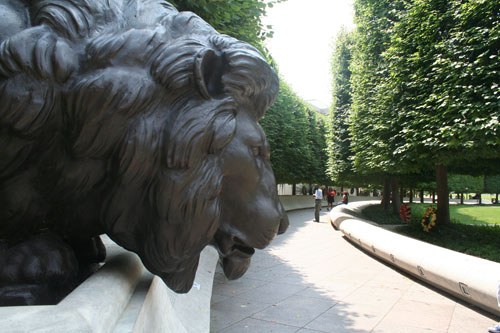
Located literally around the entrance of the Judiciary Square Metro station, the National Law Enforcement Officers Memorial is dedicated to officers on the local, federal and state levels that have died in the line of duty. New names are added every spring - during National Police Week - on the curved granite walls, which are guarded by a bronze lion on each end.
Just in front of the entrance to the Judiciary Square station is a display with guide maps that point out groups of officers who gave their lives during events like Sept. 11, the pursuit of Billy the Kid and other significant moments throughout history. (Special to WTOP/Tiffanie Reynolds)
Read More...
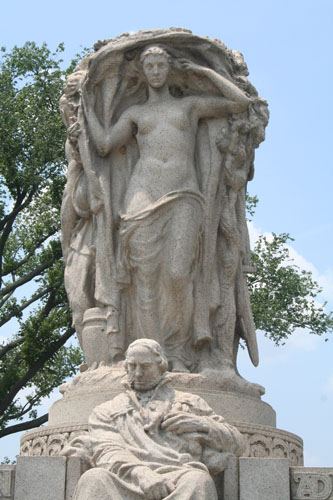
Sitting by the Potomac River on the National Mall in West Potomac Park, this statue is in honor of Ericsson's life and accomplishments. A Swedish-born engineer and inventor, his most famous accomplishment is designing the iron-plated USS Monitor, the first ironclad warship, during the Civil War. (Special to WTOP/Katy Stang & Tiffanie Reynolds)
Read More...
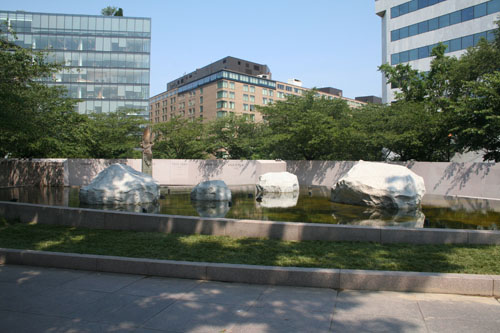
Dedicated on Nov. 9, 2000, this memorial honors those Japanese Americans who served during World War II and aims to recognize the injustice done to Japanese Americans, most of them American citizens, who were put into camps two months after the attack on Pearl Harbor. Located on the corner of D Street and Louisiana Avenue in NW, it serves to teach a piece of American history very often forgotten. (Special to WTOP/Tiffanie Reynolds)
Read More...
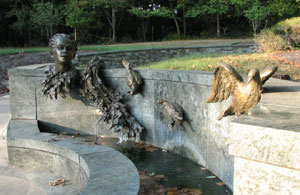
Founded in 1991, this memorial marks the beginning of the Kahlil Gibran Memorial Garden, which features imagery and lines of his poetry throughout. Gibran was an influential Lebanese-American philosophical essayist, novelist, mystical poet and artist who was born in Syria and immigrated to America with his mother and siblings in 1895. He is most known for his work "The Prophet," a book of 26 poetic essays that has been translated into more than 20 languages. He also founded a society for Arab writers in 1920. His works became influential in the 1960s, and have remained in American culture since. (Special to WTOP/Tiffanie Reynolds)
Read More...
(Photo Courtesy of Arab American Institute)
Photo Courtesy of Arab American Institute
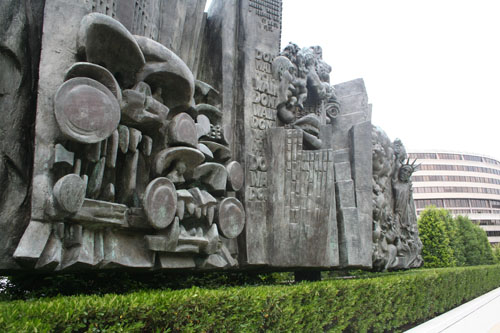
This sculpture in front of the Kennedy Center of Performing Arts is a representation of the combination of history and society that make up American life. On the left end are European immigrants fighting for sacks of grain on a ship, which represents how their perseverance and diversity make up the foundation of the U.S. today.
Going across from the left, the sculpture flows into New York City with its ferocious cars, the diversity of people that move the city and its towering skyscrapers, finally ending with the Statue of Liberty and a rocket to the moon on the right. (Special to WTOP/Tiffanie Reynolds)
Read More...
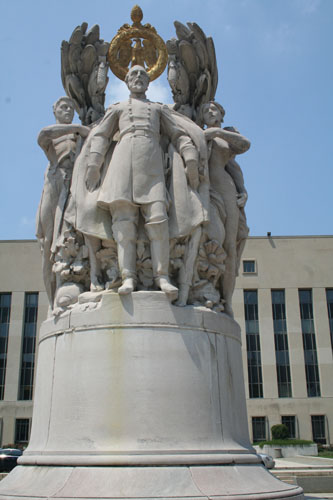
George Meade was a Union general during the Civil War and most remembered for leading the Army of the Potomac in the Battle of Gettysburg and defeating Robert E. Lee's army. His statue - located in front of the federal courthouse on Pennsylvania Avenue in NW and one of many around the country - shows him standing at the front with six figures at the sides representing Loyalty, Chivalry, Fame, Progress, Military Courage and Energy, with the winged figure of War standing directly back-to-back with him on the opposite side. (Special to WTOP/Tiffanie Reynolds)
Read More...
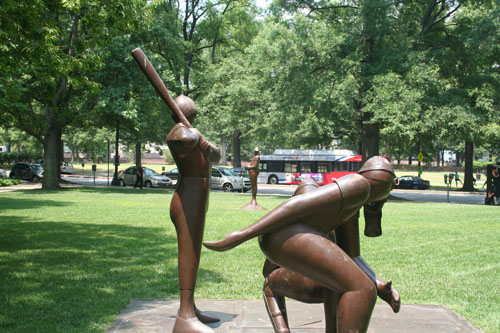
Located in the courtyard of the Federal Reserve Bank at 19th Street and Virginia Avenue in NW, this sculpture depicts a pitcher, batter, catcher and umpire in game-correct positions and distances in the small, grassy courtyard field.
John Dreyfuss, the artist behind the sculpture, has been working on the theme of baseball since 1980 and spent eight years on this sculpture, taking extra time to make sure each were in the right stance and distance as real players would be in a game. Baseball is not only an inspiration for his work, but also serves to him as a commentary on American society and culture. (Special to WTOP/Tiffanie Reynolds)
Read More...
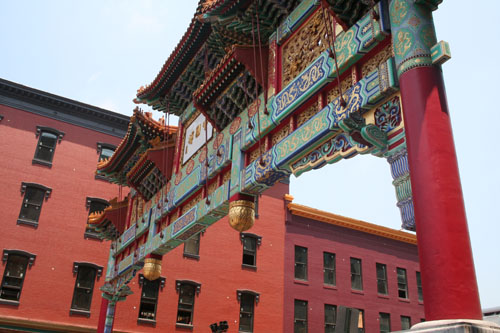
Part of what is now considered the most vibrant and lively section of downtown D.C., Friendship Archway was built in 1986 in an effort to keep what true ethnicity remained in Chinatown alive. It became a joint project between the Chinese government and D.C. - with Alfred Liu as the designer - aiming to make the archway a representation of the friendship between the U.S. and China and marking Chinatown in D.C. as a sister city to Beijing. However, controversy immediately arose as many Chinatown residents did not want to be associated with communist China at the time. A petition was made and plans for a second arch were passed around, but did not come to fruition.
Since the arch was built, a few restorations have been made, including one in 1993 and 2009. Today, it stands tall next to the entrance and exit of the Chinatown Metro station, reminding both residents and tourists alike of the slice of culture that still lingers there. (Special to WTOP/Katy Stang & Tiffanie Reynolds)
Read More...
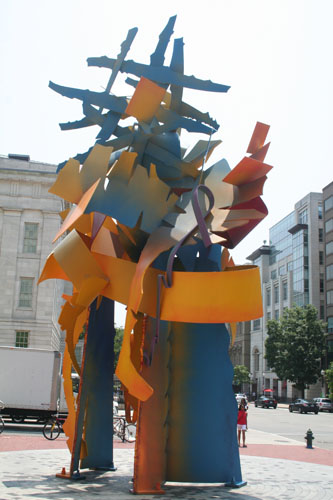
Erected in 2004 by Albert Paley, this 25-foot statue stands in front of Zaytinya restaurant. Hidden among the beautiful colors is a poem by D.C. poet laureate Delores Kendrick. The program DC Creates! Public Art commissioned the piece. (Special to WTOP/Katy Stang)
Read More...
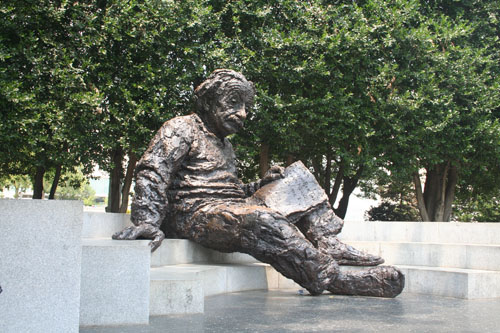
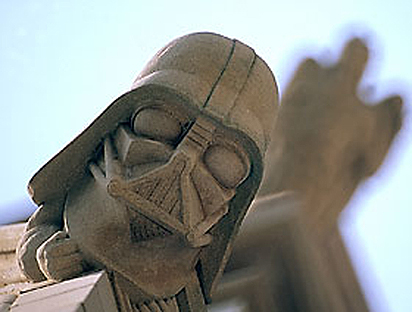
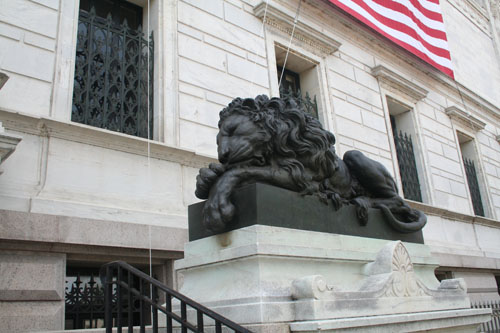
These lions, one sleeping and one watching the street in front of it, guard the Corcoran Gallery of Art. They were bought in 1888 and displayed in front of the gallery's original building, both facing the street. When moved to the new building at 17th Street and New York Avenue in Northwest, they also were moved to face each other. (Special to WTOP/Katy Stang & Tiffanie Reynolds)
Read More...
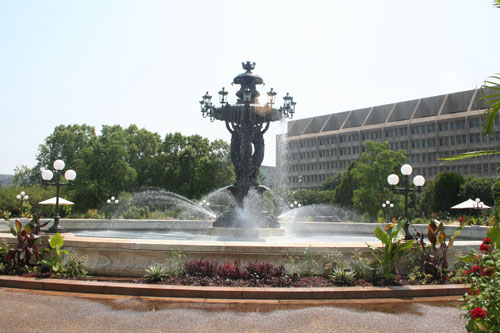
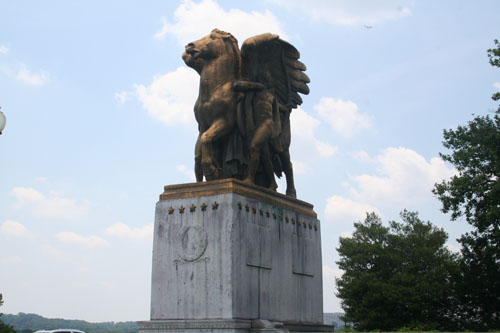
It's easy with all of the popular monuments around D.C. to miss some of the nicest. Standing behind the Lincoln Memorial, these statues created by James Earle Fraser were given to the United States by the people of Italy.
Erected in 1951, their symbolism ranges from the Civil War to mythological creatures. The statues also have a matching pair. Can you find them near the Lincoln Memorial? (Special to WTOP/Tiffanie Reynolds & Katy Stang)
Read More...
